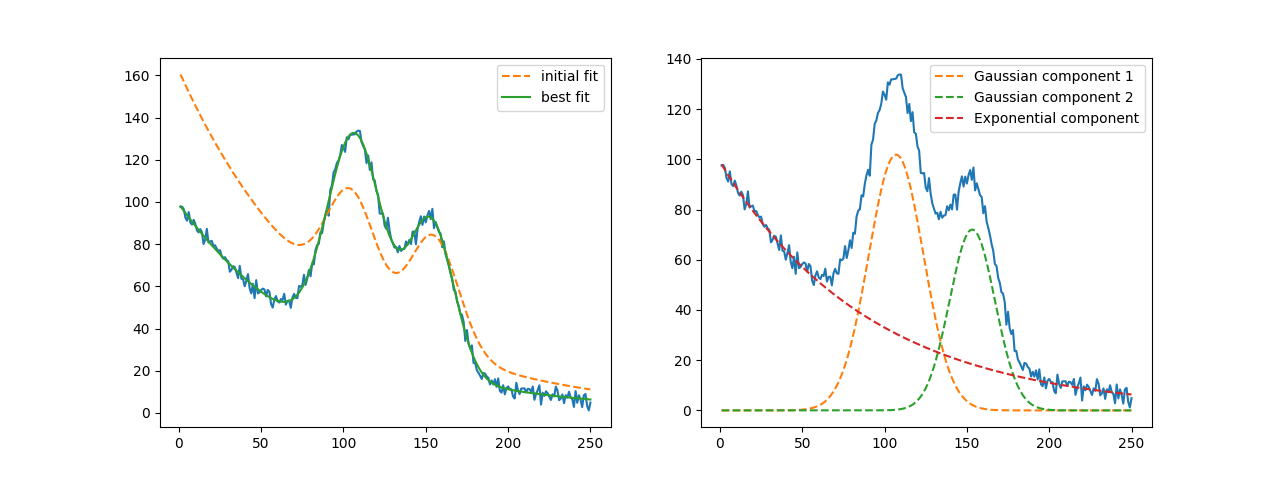Note
Go to the end to download the full example code.
Builtinmodels - nistgauss¶

[[Model]]
((Model(gaussian, prefix='g1_') + Model(gaussian, prefix='g2_')) + Model(exponential, prefix='exp_'))
[[Fit Statistics]]
# fitting method = leastsq
# function evals = 46
# data points = 250
# variables = 8
chi-square = 1247.52821
reduced chi-square = 5.15507524
Akaike info crit = 417.864631
Bayesian info crit = 446.036318
R-squared = 0.99648654
[[Variables]]
exp_amplitude: 99.0183278 +/- 0.53748593 (0.54%) (init = 162.2102)
exp_decay: 90.9508853 +/- 1.10310778 (1.21%) (init = 93.24905)
g1_amplitude: 4257.77360 +/- 42.3836478 (1.00%) (init = 2000)
g1_center: 107.030956 +/- 0.15006851 (0.14%) (init = 105)
g1_sigma: 16.6725772 +/- 0.16048381 (0.96%) (init = 15)
g1_fwhm: 39.2609181 +/- 0.37791049 (0.96%) == '2.3548200*g1_sigma'
g1_height: 101.880230 +/- 0.59217173 (0.58%) == '0.3989423*g1_amplitude/max(1e-15, g1_sigma)'
g2_amplitude: 2493.41735 +/- 36.1697789 (1.45%) (init = 2000)
g2_center: 153.270102 +/- 0.19466802 (0.13%) (init = 155)
g2_sigma: 13.8069464 +/- 0.18679695 (1.35%) (init = 15)
g2_fwhm: 32.5128735 +/- 0.43987320 (1.35%) == '2.3548200*g2_sigma'
g2_height: 72.0455941 +/- 0.61722243 (0.86%) == '0.3989423*g2_amplitude/max(1e-15, g2_sigma)'
[[Correlations]]
+---------------+---------------+---------------+---------------+---------------+---------------+---------------+---------------+---------------+
| Variable | exp_amplitude | exp_decay | g1_amplitude | g1_center | g1_sigma | g2_amplitude | g2_center | g2_sigma |
+---------------+---------------+---------------+---------------+---------------+---------------+---------------+---------------+---------------+
| exp_amplitude | +1.0000 | -0.6946 | +0.1478 | -0.0467 | +0.0218 | +0.2821 | +0.0331 | +0.1714 |
| exp_decay | -0.6946 | +1.0000 | -0.5074 | +0.1055 | -0.2520 | -0.4270 | -0.1514 | -0.2329 |
| g1_amplitude | +0.1478 | -0.5074 | +1.0000 | +0.4183 | +0.8243 | -0.3071 | +0.6477 | -0.4010 |
| g1_center | -0.0467 | +0.1055 | +0.4183 | +1.0000 | +0.5075 | -0.6689 | +0.6205 | -0.6520 |
| g1_sigma | +0.0218 | -0.2520 | +0.8243 | +0.5075 | +1.0000 | -0.4915 | +0.6842 | -0.4826 |
| g2_amplitude | +0.2821 | -0.4270 | -0.3071 | -0.6689 | -0.4915 | +1.0000 | -0.4763 | +0.8154 |
| g2_center | +0.0331 | -0.1514 | +0.6477 | +0.6205 | +0.6842 | -0.4763 | +1.0000 | -0.4889 |
| g2_sigma | +0.1714 | -0.2329 | -0.4010 | -0.6520 | -0.4826 | +0.8154 | -0.4889 | +1.0000 |
+---------------+---------------+---------------+---------------+---------------+---------------+---------------+---------------+---------------+
# <examples/doc_builtinmodels_nistgauss.py>
import matplotlib.pyplot as plt
import numpy as np
from lmfit.models import ExponentialModel, GaussianModel
dat = np.loadtxt('NIST_Gauss2.dat')
x = dat[:, 1]
y = dat[:, 0]
exp_mod = ExponentialModel(prefix='exp_')
pars = exp_mod.guess(y, x=x)
gauss1 = GaussianModel(prefix='g1_')
pars.update(gauss1.make_params(center=dict(value=105, min=75, max=125),
sigma=dict(value=15, min=0),
amplitude=dict(value=2000, min=0)))
gauss2 = GaussianModel(prefix='g2_')
pars.update(gauss2.make_params(center=dict(value=155, min=125, max=175),
sigma=dict(value=15, min=0),
amplitude=dict(value=2000, min=0)))
mod = gauss1 + gauss2 + exp_mod
init = mod.eval(pars, x=x)
out = mod.fit(y, pars, x=x)
print(out.fit_report(correl_mode='table'))
fig, axes = plt.subplots(1, 2, figsize=(12.8, 4.8))
axes[0].plot(x, y)
axes[0].plot(x, init, '--', label='initial fit')
axes[0].plot(x, out.best_fit, '-', label='best fit')
axes[0].legend()
comps = out.eval_components(x=x)
axes[1].plot(x, y)
axes[1].plot(x, comps['g1_'], '--', label='Gaussian component 1')
axes[1].plot(x, comps['g2_'], '--', label='Gaussian component 2')
axes[1].plot(x, comps['exp_'], '--', label='Exponential component')
axes[1].legend()
plt.show()
# <end examples/doc_builtinmodels_nistgauss.py>
Total running time of the script: (0 minutes 0.630 seconds)
